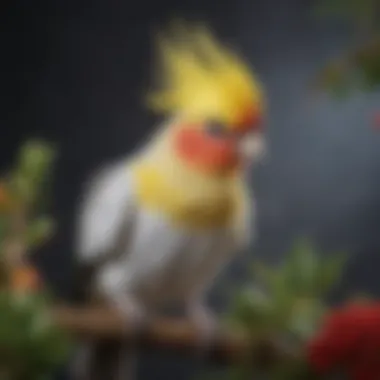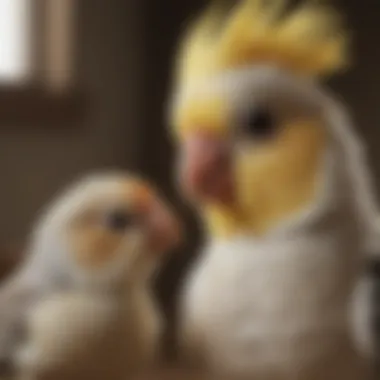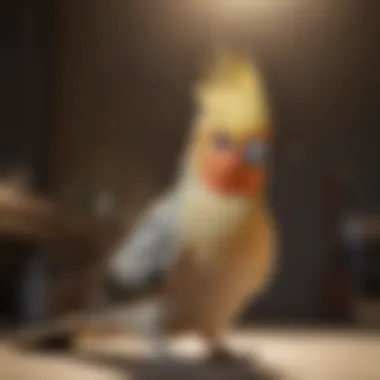Evaluating Cockatiels as Ideal Companion Pets


Intro
Cockatiels are more than just colorful birds flitting about in a cage; they are lively companions that can enrich a household with personality and affection. As potential pet owners ponder the suitability of cockatiels, it's crucial to delve into the nuances that make these birds both charming and demanding. The exploration of their behaviors, needs, and emotional capabilities can be a deciding factor for many families. This section sets the stage for a comprehensive look at these feathered pets, ensuring that future owners are well-informed and ready to make a commitment.
Animal Overview
Common Name and Scientific Classification
Cockatiels, known scientifically as Nymphicus hollandicus, are a popular choice among bird lovers. These small parrots, originally hailing from Australia, have made their way into homes worldwide due to their friendly nature and relatively simple care requirements.
Physical Characteristics
Without a doubt, cockatiels are notable for their striking appearance. Their size is manageable for most households, averaging about 12 to 14 inches in length. Characteristically, males often exhibit bright orange cheek patches and a striking yellow crest, while females tend to be more subdued in color. Their plumage features a range of gorgeous hues, from gray to white, and their long tail creates an elegant silhouette when they spread their wings.
Habitat and Distribution
In the wild, cockatiels thrive in the bushlands and grasslands of Australia. They are social birds that often flock together, foraging for seeds and grains. When considering their new home, it’s imperative to replicate this social atmosphere where they can engage and feel secure. Creating an environment that resembles their natural habitat not only improves their quality of life but also fosters a deeper bond with their human companions.
Behavior and Social Structure
Communication Methods
Cockatiels are not just quiet inhabitants; they are expressive and communicate through a range of sounds. From soft whistles to loud chirps, they have a considerable vocal repertoire. Many owners find joy in teaching their birds simple tunes or phrases, further enhancing their interactive experience.
Social Hierarchies
In their groups, cockatiels establish visible social hierarchies. These dynamics can be crucial to understand for maintaining harmony in a multi-bird household. Ranking among these birds often affects their interactions, and owners must ensure that they are not inadvertently fostering tension or competition among their pets.
Mating and Reproductive Behavior
As for mating, the courtship display of cockatiels is quite amusing. Males will often bob their heads and perform a dance to woo females. If breeding becomes a consideration, it is essential to be informed about their reproductive behaviors, egg-laying periods, and care for chicks. This requires a dedicated space and proper conditions to ensure the healthy growth of the young.
Conservation Status
Current Population Trends
While cockatiels are widely available as pets, it’s crucial to recognize their status in the wild. Conservation efforts have noted various trends affecting their populations. As of recent assessments, they are not yet endangered, but habitat destruction poses ongoing threats to their native range.
Threats and Challenges
Urban expansion and agriculture have chipped away at the natural habitats that cockatiels rely on. Over-trapping, although regulated, also contributes to their decline in certain regions, emphasizing the need for responsible practices when acquiring these pets.
Conservation Efforts and Success Stories
Organizations and enthusiasts alike have been working towards conservation by educating the public and promoting responsible ownership. Initiatives range from habitat restoration projects to successful breeding programs in captivity, aiming to ensure that future generations can enjoy these delightful birds.
"The bond shared between a pet and owner enriches lives, but it comes with distinctive responsibilities - understanding these traits in cockatiels is key to nurturing that connection."
Prelude to Cockatiels


When considering the prospect of adding a feathered friend to one’s family, it’s essential to understand not only the species itself but also its quirks, needs, and unique charm. Cockatiels, known for their vibrant personalities and lively behaviors, are often seen as ideal pets for those looking to share their lives with a companion that brings a touch of whimsy to their homes. In this section, we embark on a brief journey through the origins and physical traits of these delightful birds, laying a foundation for the deeper exploration of their behavioral patterns and care requirements that will follow.
Origin and History
Cockatiels, scientifically recognized as Nymphicus hollandicus, hail from the sun-drenched expanses of Australia. Their lineage can be traced back to the early 1800s, when they were first established as a distinct species. The natural habitat of cockatiels consists primarily of open grasslands and scrublands, where they form flocks and communicate through their distinctive calls. The birds’ transition from wild creatures to beloved pets began in the late 19th century when they were successfully bred in captivity.
This shift not only modernized their presence but also diversified their color variations. Today, one can find delightful color morphs such as pieds, lutinos, and even pearls among them. Each variety exhibits unique patterns and shades that make them visually appealing companions. The journey from the Australian outback to cages worldwide signifies not just a change in environment, but also a growing bond between humans and cockatiels, essentially rewriting their social story.
Physical Characteristics
Cockatiels are relatively small, with most adults measuring around 12 to 14 inches in length. Their signature features include a charming crest atop their head, which can be raised or lowered depending on their mood. One might say their crest acts like a mood ring, waving in response to excitement or agitation.
In terms of plumage, cockatiels are often recognized by their predominantly gray feathers, while their cheeks glow with splashes of vibrant orange. Males usually flaunt brighter colors, especially during the breeding season, whereas females tend to have more subdued hues, which serve as camouflage in the wild. Several of these birds may sport long tail feathers that develop striking patterns, providing visual intrigue as they flit about the space they inhabit.
Behavioral Traits of Cockatiels
Understanding the behavioral traits of cockatiels is crucial for anyone considering bringing one of these delightful birds into their home. These traits not only reflect how these pets interact with their environment but also reveal their compatibility with owners and families. Emphasizing social behaviors, communication skills, and intelligence levels helps illustrate the complexity and charm of cockatiels as companion animals. This insight aids potential pet owners in making informed decisions about their new feathered friends.
Social Nature
Cockatiels are known for their lively and engaging social nature. They thrive on interaction, both with their human companions and with other birds. This gregarious behavior makes them particularly popular among families who seek a pet that can bond closely.
- Affectionate Companions: Cockatiels enjoy spending time with their owners, often displaying affection through gentle nibbles and nuzzles. They can learn to recognize their humans and often seek attention, which speaks volumes about their emotional intelligence.
- Group Behavior: In the wild, cockatiels are social creatures, living in flocks. This instinct is carried into captivity; they often do better in pairs or with regular interaction from their human families. If left alone for long periods, they may become lonely, leading to behavioral issues.
- Playful Personalities: With their playful demeanor, cockatiels can engage in a variety of activities that stimulate their minds. Toys that require manipulation, like shredding or climbing, can keep them entertained. Their social nature makes them adaptable, often fitting well into the rhythm of family life.
Communication Skills
The ability of cockatiels to communicate adds another layer to their value as pets. Whether through vocalizations or body language, these birds express a range of emotions, often mimicking sounds from their environment.
- Vocal Mimicry: Cockatiels are known for their impressive vocal abilities. They can mimic not just human speech but also household sounds, like doorbells and timers. This talent can create a lively atmosphere in the home, making their presence felt even when they’re perched quietly.
- Body Language: Understanding their body language is essential for proper interaction. For instance, a cockatiel with raised feathers might be feeling defensive, while one that leans forward suggests curiosity or playfulness. Recognizing these signals helps deepen the bond between the pet and its owner.
"Cockatiels are often regarded as one of the most affectionate species of pet birds, displaying both vocal and physical forms of communication with remarkable ease."
- Expressive Sounds: Beyond mimicry, they have a varied repertoire of chirps and whistles, each signifying different moods or needs. Owners who take time to respond to these vocal cues often find greater satisfaction in their relationship with their cockatiel.
Intelligence Levels
Cockatiels are regarded as intelligent creatures, capable of learning and problem-solving, which further enriches their role as companions.
- Learning Tricks: Their ability to learn tricks can be quite astonishing. With patience and positive reinforcement, cockatiels can be taught to perform simple tasks, such as turning in circles or playing fetch. This not only provides mental stimulation but also strengthens the bond between pet and owner.
- Puzzle Solvers: They exhibit a natural curiosity and often approach new challenges with enthusiasm. Providing them with puzzles or interactive toys encourages cognitive engagement, essential for their happiness and well-being.
- Social Learners: This intelligence also translates to their social interactions. They quickly pick up on their owners' moods and behaviors, adapting their actions accordingly. This responsiveness means that the bond formed can be both fulfilling and rewarding.
Care Requirements for Cockatiels
Understanding the care requirements for cockatiels is essential for any potential owner evaluating their suitability as a pet. These birds, known for their lively characters and engaging mannerisms, require proper attention to thrive both physically and mentally. Providing the right conditions not only ensures a healthy environment but also promotes a strong bond between the cockatiel and its owner. Each aspect of care—diet, housing, and health—plays a significant role in the overall well-being of these charming companions.
Dietary Needs
Cockatiels, like any pets, depend on a balanced diet tailored to their specific needs. They are primarily granivorous, which means seeds form a large part of their diet. However, relying solely on seeds can lead to nutritional deficiencies. Thus, it is crucial to offer a varied diet that includes:
- Pellets: Considered a staple, high-quality pellets provide essential vitamins and minerals.
- Fresh Fruits and Vegetables: Options like carrots, broccoli, apples, and spinach enrich their diet with fiber and antioxidants.
- Grains: Cooked quinoa, rice, or barley add variety and nutrients.
Ensuring fresh water is always available is just as critical. Regularly refreshing their drinking water helps prevent bacterial growth and promotes hydration. Careful observation of your cockatiel’s eating habits can also reveal insights into its health—any sudden changes may warrant a closer look.


Housing and Environment
Creating an optimal living environment for a cockatiel is paramount. The cage should be spacious enough to allow for comfortable movement, ideally measuring at least 24 x 24 x 36 inches for a pair of cockatiels, with horizontal bars that enable climbing. Here are essential features to consider:
- Placement: Choose a location away from drafts, direct sunlight, and extreme temperatures. Cockatiels thrive in a stable environment.
- Safety: Ensure the cage is made of non-toxic materials, as cockatiels tend to chew everything in sight.
- Bedding and Accessories: Provide a mix of perches, toys for stimulation, and bedding materials that absorb waste and odors.
An enriched environment helps keep cockatiels entertained. Rotate toys and introduce new ones regularly to prevent boredom, as these birds are quite intelligent and curious. It’s also worth noting that cockatiels do better when they have sufficient social interaction, whether with their owners or other birds. Overall, a well-maintained living area nurtures both the physical and emotional aspects of your feathered friend.
Health Considerations
Owning a cockatiel comes with the responsibility of ensuring its health. Regular veterinary visits are crucial for monitoring overall well-being and preventing potential health issues that can arise from neglect. Key factors to bear in mind include:
- Routine Check-ups: Schedule annual vet appointments to keep vaccinations current and check for any signs of illness.
- Signs of Distress: Be aware of behavioral changes, such as lethargy or lack of appetite, as they can indicate underlying issues.
- Grooming: Maintain regular nail trimming and occasional baths to prevent feather damage and encourage cleanliness.
"A healthy bird is a happy bird; proactive care ensures a longer, more fulfilling life for your cockatiel."
Socialization and Interaction
The dynamics of socialization and interaction play a vital role in the overall value of cockatiels as pets. These birds have a distinct behavioral repertoire that hinges on their social needs. A well-socialized cockatiel can become a delightful companion, often exhibiting affectionate traits resembling those of a dog or cat. Understanding how to foster these interactions can greatly enhance the bond between bird and owner, ultimately leading to a fulfilling relationship.
Bonding with Owners
Bonding with owners is paramount when it comes to cockatiels. These birds are known for their friendly demeanor and curious personalities. Cockatiels thrive on social interaction, and when you spend time with them, they can quickly come to see you as a part of their flock. Gradually approaching them with patience, offering treats, and vocalizing can work wonders.
Stroking their feathers gently or letting them perch on your shoulder are great ways to build trust. Over time, they’ll become more playful and responsive. It's worth noting that each bird is unique in how quickly they bond. Some may warm up quicker than others, so it’s essential to allow them to adjust at their own pace.
Points to consider when bonding with your cockatiel:
- Time Commitment: Consistent daily interaction is necessary.
- Positive Reinforcement: Use treats as rewards for desired behaviors.
- Respect Their Space: Know when to back off if they seem overwhelmed.
"A cockatiel's world is built on trust, and with patience, that world grows richer every day."
Compatibility with Other Pets
When introducing a cockatiel into a household with other pets, especially dogs or cats, one must tread lightly. Cockatiels are generally social animals that can coexist with various companions, but supervision is key. The hierarchical nature of households can play a role in how these interactions unfold.
Here’s what to keep in mind regarding compatibility:
- Supervision is Crucial: Never leave cockatiels unattended with predatory pets. Their small size makes them vulnerable.
- Positive Introductions: Gradual introductions can ease potential tension. Allow the cockatiel to observe the other pets from a safe distance before any direct contact.
- Watch for Body Language: Learning what confident or nervous behavior looks like in both the bird and other pets can prevent misunderstandings.
- Creating Safe Spaces: Ensure that your cockatiel has safe areas to retreat if they feel threatened or anxious.
As diverse as pet households can be, ensuring a peaceful atmosphere for all animals is essential for maintaining harmony. In some cases, isolated interactions with non-predatory pets, like certain rodents, can yield positive outcomes, but thorough understanding of each species is critical.
Ultimately, successful socialization and interaction can profoundly shape the life of your cockatiel and enhance the overall pet ownership experience.
Pros and Cons of Owning a Cockatiel
Advantages as Pets
Cockatiels have earned their stripes in the avian pet community for good reasons, making them a preferred choice for many animal lovers. Here are some key advantages:
- Affectionate Companionship: Cockatiels are known for their friendly demeanor. They tend to bond closely with their owners, often seeking attention and interaction. Their playful nature brings joy and laughter to a household.
- Easy to Train: With a bit of patience and consistency, cockatiels can be trained to perform simple tricks and even mimic some sounds. Their intelligent nature means they thrive on mental stimulation, making training both a rewarding and enjoyable task.
- Moderate Space Requirements: Unlike larger parrots, cockatiels don’t require massive cages or extensive living spaces. They are adaptable birds that can thrive in smaller environments, provided they have the opportunity to stretch their wings outside the cage regularly.
- Variety and Personality: They come in various colors and mutations, allowing for a unique expression of personality through appearance. Each bird develops its own quirks, making them dynamic members of any family.
- Longevity: With proper care, cockatiels can live for fifteen years or more. This long lifespan means that they can become integral parts of their owners' lives, providing years of enjoyment and companionship.


Challenges in Care
Though cockatiels bring a lot of joy, potential owners must also navigate certain challenges to ensure a healthy and happy pet. Here are some hurdles to consider:
- Daily Attention Necessary: These birds thrive on interaction, which requires owners to dedicate time daily. Neglecting their social needs can lead to behavioral issues, such as excessive screaming or feather plucking.
- Dietary Needs: Maintaining a balanced diet is crucial. Cockatiels need a mix of seeds, pellets, fresh fruits, and vegetables to stay healthy. Not all owners are prepared for the effort required to provide the right nutrition regularly.
- Health Considerations: Cockatiels can be prone to various health issues, including respiratory problems and feather diseases. Regular veterinary check-ups are essential, and unexpected medical expenses can add up.
- Noise Levels: While generally quieter than larger parrot species, cockatiels can still be noisy, especially when interacting or unhappy. Their vocalizations can be surprising for first-time owners.
- Social Hierarchies: When introducing cockatiels to other pets, there can be challenges regarding social dynamics. Familiarizing existing pets with a new bird is often a delicate process that requires patience.
"Owning a cockatiel is a delightful experience, but like any living creature, they require commitment and understanding of their needs."
Environmental and Ethical Considerations
In evaluating the worth of cockatiels as pets, it is crucial to delve into environmental and ethical considerations. This topic carries significant weight, as both the reader’s sense of responsibility and the well-being of the birds hinge on an understanding of where these creatures come from and how they fit into our ecosystem. Cockatiels are not just playful companions; they are living beings with complex needs that should be respected in our care.
Origin and Breeding
Cockatiels trace their roots back to Australia, where they thrive in the wild. Understanding their natural habitat can shed light on their needs as pets. In the bushlands and scrub areas, these birds nurture social groups, navigate open skies, and engage in foraging behaviors. Captivity presents a different environment that often lacks the space and stimulation found in their native surroundings.
From a breeding perspective, ensuring ethical practices is paramount. Unfortunately, not all sources adhere to rigorous standards. Some breeders may prioritize profit over the welfare of the birds, leading to practices that compromise the animals’ health, both physically and mentally. For potential owners, finding reputable breeders who prioritize the birds' well-being—offering proper socialization and health checks—is essential.
Additionally, this aspect ties into the wider conversation about pet shops and their role in breeding. It’s a shaky ground; while they may seem convenient for purchasing a new companion, not all establishments offer the same commitment to ethical practices. A little research can take you a long way; investigating the origin of the cockatiel can mean the difference between a thriving, healthy pet and one that struggles under the weight of poor planting practices.
Conservation Status
The conservation status of cockatiels is an essential conversation in light of pet ownership. In the wild, these birds face habitat loss due to agriculture and urban development. As agricultural habits evolve, the territories of these birds shrink, leading to declining populations. Their well-being in the wild reflects on our choices as pet owners and showcases the delicate balance we exist within.
Sustainable practices in pet ownership can impact conservation positively. If potential owners prioritize adopting rescue birds or supporting conservation programs, they contribute to preserving not just individual birds but also the environments they come from. Understanding the implications of patronizing specific sources for pets serves as a valuable lens through which to view our responsibilities.
"Your pet's happiness and health begin long before you bring it home; it starts with the choice of where it comes from."
In summary, the conversation around environmental and ethical considerations isn't just a one-time discussion; it's a continuous thread running through the fabric of responsible pet ownership. The choices we make affect not only the cockatiels we care for but also the larger ecological systems they are part of. Potential owners need to reflect deeply on these matters, ensuring their commitment to ethical practices aligns with the love and care they wish to provide.
Culmination: Are Cockatiels Good Pets?
When considering a cockatiel as a pet, one must weigh a range of significant factors that ultimately shape whether these charming birds wind up being a suitable companion. The question of whether cockatiels are good pets evokes a blend of practical realities and emotional considerations. While their endearing nature often draws potential owners to them, other aspects, like care demands and lifestyle compatibility, merit deeper analysis.
Firstly, it's essential to highlight the innate characteristics of cockatiels. Their playful demeanor and social nature often make them instant favorites in many households. They thrive on interaction, which can foster a sense of companionship akin to that of a dog or cat. However, these social creatures require continuous engagement to flourish emotionally. A family that spends ample time together might find a cockatiel's vibrant personality a perfect match, enriching daily life with its unique quirks. Adversely, those who are frequently away may find a cockatiel is like a plant that needs more sunlight — the absence can stifle its spirit.
Secondly, proper care needs should not go unchecked. As much as these birds can light up a room, they come with specific requirements for diet, housing, and health. Providing a balanced diet, suitable habitat, and regular vet checkups are non-negotiable parts of keeping a healthy cockatiel. These considerations can quickly tally up, demanding time and financial resources from the owner.
In assessing if cockatiels are a good fit, one should ponder the practical elements alongside the emotional. The balance between the relational joy these birds can offer and the responsibilities that come with them is a tightrope walk that potential owners must navigate thoughtfully.
"Every pet teaches you a lesson in responsibility and patience, and cockatiels are no exception."
Their benefit lies not just in being adorable companions but also in the emotional support they provide and the joy that seems to emanate during interaction. Ultimately, they can be rewarding pets if aligned with the owner's values and lifestyle, making the final decision far from simple.
Summary of Key Points
- Social Nature: Cockatiels are highly social and bond well with humans and other pets, providing a rich interactive experience.
- Care Requirements: Owners need to commit time and resources to meet their dietary, housing, and health needs.
- Emotional Fulfillment: For families that are present and engaged, cockatiels can offer abundant joy and companionship.
- Lifestyle Compatibility: Consider personal and family schedules; birds thrive in environments where they’re a part of daily routines.
Final Thoughts for Potential Owners
For anyone contemplating introducing a cockatiel into their home, it's paramount to reflect on personal intentions and lifestyle. These birds can enhance life qualitatively, promoting warmth and lively exchanges. However, understanding their requirements, temperaments, and how they fit into family dynamics cannot be overstressed.
Before making a decision, consider these questions:
- Do you have the commitment to care for a living being that thrives on interaction?
- Can you provide the necessary environment and dietary needs?
- Is your household ready for the potential noise and activity that comes with a cockatiel?
In wrapping up, the charm of cockatiels lies in their ability to connect emotionally with their owners, while their needs certainly require diligence. With these factors in a fine balance, they can indeed become cherished members of any family.







